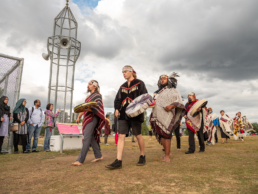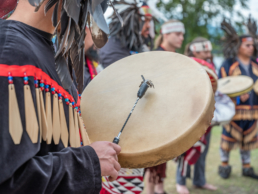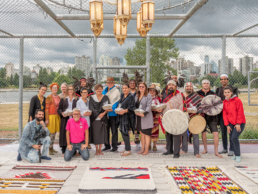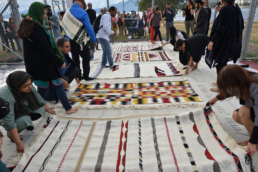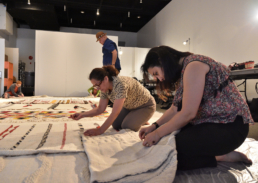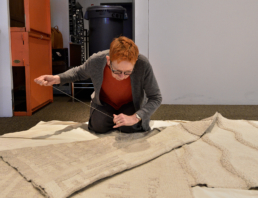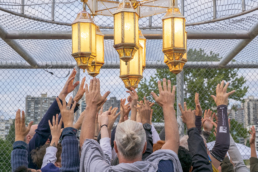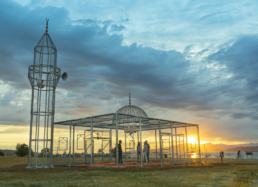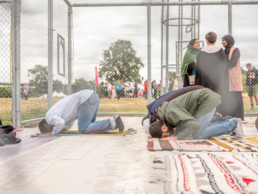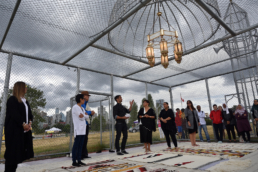April 23 – August 29, 2020
Contemporary Native Art Biennial (BACA), 5th edition
Kahwatsiretátie : Teionkwariwaienna Tekariwaiennawahkòntie
Honoring kinship
Curated by David Garneau (Métis), with the assistance of rudi aker (Wolastoqiyik) and Faye Mullen.
Weaving Cultural Identities: Threads Through Time.
Artists: Angela George (Squamish and Tsleil Waututh), Chepximiya Siyam’ Chief Janice George (Squamish) and Skwetsimeltxw Willard ‘Buddy’ Joseph (Squamish), Debra Sparrow (Musqueam), Doaa Jamal, Efemeral, Krista Point (Musqueam), Mary Lou Trinkwon, Robyn Sparrow (Musqueam), Ruth Scheuing
The Vancouver Biennale’s Weaving Cultural Identities: Threads Through Time will be exhibited as part of BACA 2020: The Biennale d’art contemporain autochtone (BACA) / Contemporary Native Art Biennial at Art Mur, Montreal QC. The exhibition features 5 large weavings by 6 renowned Musqueam, Squamish and Tsleil-Waututh weavers, surrounded by a large Jaquard-woven border featuring a poem by Muslim Poet Efemeral. It will be on display until Aug 29 2020.
As an extension of its first phase Weaving Cultural Identities, Weaving Cultural Identities: Threads Through Time has invited Indigenous and multi-ethnic weavers to engage in conversations about colonization and the subsequent demarcations of unceded lands.
Through these reflections, the weavers have created five individual weavings, channeling their experience of the land through the voices of their ancestors. Inspired by this dialogue and in honoring these experiences, a team of Jacquard weavers and a designer created a large border which holds these weavings together, cumulating to 31 by 15 feet rug. In this border, a poem is woven in Arabic, reflecting the weavers’ acknowledgment and respect to Muslim migrant experiences.
They were exiled from their mosques
And in their mosques martyred
So in the expanse of their exile and martyrdom
They built a mosque
– Efemeral
The Weaving Cultural Identities project is a multipart project by the Vancouver Biennale that brings together Indigenous and Islamic communities in a collaborative exploration of weaving traditions and histories. It was inspired by Saudi Arabian artist, Aslan Gharem’s public installation Paradise Has Many Gates, a chain-link mosque installed in Sen̓áḵw – Vanier Park, Vancouver BC as part of the 2018-2020 Vancouver Biennale curatorial theme: re-IMAGE-n. By reimagining Vancouver’s Indigenous and migrant communities’ loss of identity and sacred traditions through displacement, we can work towards reintroducing traditional practices that reflect spiritual healing and cultural restoration.
Statement
The poem by a young Muslim poet, Efemeral, is woven into the border of the 31×15 foot tapestry that frames the five monumental Coast Salish weavings of Threads Through Time. These words echo the depth and resilience of faith and tradition in the face of oppression, underpinned by the experience of exile, return, and rebuilding. Its verse can be repeated as a cyclical rhythm of history.
Across the world, textile traditions have been a vehicle for preserving and transferring knowledge–a form of documenting the present while looking to the past and shaping the future. Textiles are linked intrinsically to the creation, care, and demarcation of sacred and spiritual space, whether through prayer rugs, carpets, weavings, shawls, blankets, robes, or regalia. Weaving is also a universal language of care and shelter, of keeping the wearer warm and protected.
This project was created in response to Paradise Has Many Gates (a public art installation by Saudi Arabian artist Ajlan Gharem) that was launched in 2018 as part of the 2018-2020 Vancouver Biennale. Paradise Has Many Gates takes the shape of a chain-link fence mosque, situated in Vanier Park on Vancouver’s picturesque waterfront. The city of Vancouver is built on the unceded traditional ancestral territories of the Musqueam, Squamish, and Tsleil-Waututh nations. Until 1913, the site of the installation was a Squamish village called Sen̓áḵw, whose residents were forced off their land, and their homes burnt to the ground to make way for the creation of the park and the expansion of Vancouver’s urban sprawl.
Threads Through Time was conceived as a dialogue to address this history of displacement, and the role of spirituality and dialogue across cultures. The artwork was made to cover the floor of Paradise Has Many Gates, which appears as an enigmatic and ephemeral representation of a religious structure placed on unceded lands. Its provisional cage-like construction is both sheltering and disquieting: the building feels out of place, as if a mirage or a memory. While its architecture offers a moment of spiritual shelter and a sense of belonging to the many displaced peoples of Islamic faith who live in Vancouver, it is simultaneously a flashback to the violence and restriction inflicted in the name of religion and colonial expansion.
Knowledge, techniques, and materials of Coast Salish weaving were suppressed through colonial violence for generations. Angela George, Chief Janice George and Buddy Joseph, Krista Point, Debra Sparrow, and Robyn Sparrow–the six artists who worked together on this artwork–have all been instrumental in bringing the language of weaving back from the brink, through the labour of studying cultural belongings in museum collections around the world, speaking to Elders, learning about technique and pattern, and bringing these traditions into the present to pass down to future generations.
This project is the first time in 200 years that the three nations have collaborated in this way, and the resulting monumental weaving is a celebration and a powerful statement of cultural revival and the power of dialogue. For the artists, the process of weaving is a direct link to the ancestors whose voice speaks through patterns, colours, dyes, wool, and technique. Through collective making, this artwork has lent a platform for uneasy conversations, whilst providing an opportunity for learning about the Other and addressing centuries of oppression. The project is a visual manifestation of dialogues surrounding Reconciliation, and the sharing and celebration of cultural knowledge, symbolism, and self-identification.
Through reflections on ways in which land has been colonized, shared and demarcated, the weavers have created five individual, unique panels of 8 by 4 feet each. Inspired by this dialogue and honoring these experiences, jacquard weavers Ruth Scheuing and Mary Lou Trinkwon, and Muslim designer Doaa Jamal, created a large border which will hold these panels together to form a 31 by 15-foot tapestry that acts as a symbol and a document of this exchange. As this project tours Canada and other countries, Threads Through Time offers a methodology and a metaphor for bringing communities together through traditional knowledge and acting as a catalyst for unpacking questions of cultural belonging, displacement, diaspora, and the land.

